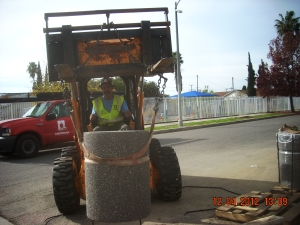While the concrete cured, the crew focused on several elements as illustrated in the following photographs



At the end of November, rain was predicted, and with an incomplee bio-swale, the crew protected the project site from sediment carried in runoff. Construction was halted for several days.
Preparing for rain
Rain delayed construction
When it was dry enough to work, the crew focused on completing the forebay and the weir apron.


If you’ve ever wondered, bollards” are structural elements – often posts – that allow pedestrians access but block vehicles from entry. Bollards at the entries of the Paseo make it easier for pedestrians, strollers, and carts to acces the Paseo.


During the final days of construction, the crew installed the green screen, refined the eleveation points for the bio-swale, and planted more than 10,000 plants native to southern California.
A green screen provides a structure for native vines to grow and adds an element of interest to the length of the Paseo.





A resident appreciated the opportunity to test the “strollability” of the almost complete Paseo.

The Paseo, ready for pedestrians and rain.

The Council for Watershed Health would like to express our appreciation to the residents adjacent to the Paseo and in the neighborhood for their patience with the various construction activities.
We also thank our project funders:
Urban Greening Proposition 84, Strategic Growth Councill, State of California
Santa Monica Mountains Conservancy
Proposition O, Bureau of Sanitation, City of Los Angeles
Department of Water & Power, City of Los Angeles




























